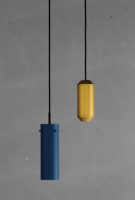When architect Tadao Ando first opened his Osaka office in 1969, he purchased four Hans Wegner Wishbone Chairs. Little did he know that, some 40 years later, he too would work with Carl Hansen & Søn, the Denmark-based firm responsible for the 1950 Wegner original, as well as for the lion's share of the Danish furniture designer's work. The first collaboration between Ando and the manufacturer, the Dream Chair is poised to make its debut in January. Comprising a shell made of 3-D form-pressed Beech plywood sandwiched between decorative layers of oak or walnut veneer, the elegant lounge chair pairs the architect's refined eye for form and materials with the manufacturer's skill.
Tadao Ando, seated comfortably in his Dream Chair was inspired by the wood furniture of the late Danish designer Hans Wegner and developed this seat—his first production piece—in layers of that material for Carl Hansen & Søn, the manufacturer of Wegner’s work.
Ando does create custom furnishings for his buildings, but the Dream Chair is his first production piece for a broader market. And while Carl Hansen & Søn has produced classic modern furniture with many notable Danish designers in its 100-plus-year history, this is the family-run company's first joint venture with a Japanese architect. Keen to explore new directions, Knud Erik Hansen, the current head of the company founded by his grandfather in 1908, began looking beyond Denmark's borders for design talent. This search led him to Japan, the company's largest export market for the past 25 years. Impressed by Ando's work with concrete and his concern to keep material waste minimal, which dovetails with the company's philosophy, Hansen approached the designer, who promptly accepted the invitation.
“I was struck by Carl Hansen's passion for making something special, with phenomenal craftsmanship,” explains Ando, who has a like-minded approach to architecture. Though his buildings are significantly bigger than a chair, his design process remained constant. The main difference was in the choice of material. While Ando's use of concrete for his structures is legendary, this time he opted for wood. “As with concrete, I wanted to create something unique from a material that is accessible anywhere on the planet,” he notes.
Yet when the Carl Hansen technicians saw Ando's initial sketches of a single sinuous plane forming the chair's back, seat, and base, they blanched. Bent in two directions, it cupped the body in a wood shell devoid of hardware. “If it were a cast fiberglass piece, there would be no problem,” says Hansen. The concern was that the chair's large size and complex curvature exceeded the capability of 3-D wood-veneer-shaping technology that entails pressing 0.39-inch thick sheets together in a mold.
Ando collaborated with the Hansen fabrication team, which manipulated the most innovative molding methods available to achieve the architect's desired result—with minimal modification to his original scheme. “Together,” says Hansen, “We challenged, and maybe reached, the limits of what is possible with plywood.”
The chair reads as a unified whole. In fact, it consists of three distinct pieces, a headrest, seat, and base. Attached to the seat back, the headrest is a simple disk that, like the seat, may be covered in leather or fabric. Playing on solid and void, its oval shape repeats as openings in the seat back and C-curved base, which was the most challenging element. More than a year of study and prototype-testing was required to make it sturdy enough to support the weight of a user and yet maintain the same thin profile as the seat. Though the technicians suggested making it in metal, Ando held out for wood but approved the addition of four steel pegs that discreetly pin the base and seat together.
Sculptural as well as ergonomic, the Dream Chair is a work of art, and priced accordingly, from $4,995 for wood and from $6,050 with leather upholstery. But when one sits back and relaxes into its warm embrace, the chair takes on its intended function. The idea, explains Hansen, is that “it embodies Tadao Ando's desire to encourage people to take more time to dream.”











Post a comment to this article
Report Abusive Comment